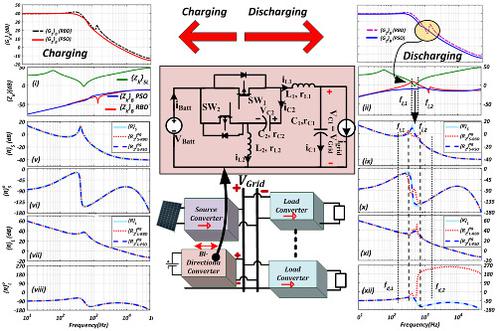当前位置:
X-MOL 学术
›
Int. J. Circ. Theory Appl.
›
论文详情
Our official English website, www.x-mol.net, welcomes your
feedback! (Note: you will need to create a separate account there.)
A fourth-order bidirectional DC–DC converter for interfacing battery in a solar -photovoltaic-fed low-voltage residential DC nano-grid: Design and analysis
International Journal of Circuit Theory and Applications ( IF 1.8 ) Pub Date : 2021-04-21 , DOI: 10.1002/cta.3016 Anmol Ratna Saxena 1 , Ashima Kulshreshtha 1
International Journal of Circuit Theory and Applications ( IF 1.8 ) Pub Date : 2021-04-21 , DOI: 10.1002/cta.3016 Anmol Ratna Saxena 1 , Ashima Kulshreshtha 1
Affiliation

|
In this paper, a non-isolated fourth-order bidirectional DC–DC converter (FoBiDC) which exhibits continuous input and output current together with minimum-phase response, both during buck and boost modes, is proposed and analyzed. It is then used to interface a battery in a solar photovoltaic (SPV) fed low-voltage low-power residential DC nano-grid (LVRDNG). The design equations for the converter are derived by performing steady-state and time-domain analysis. The small-signal models are developed and used for designing voltage-mode controller to regulate the DC bus voltage of LVRDNG and perform stability analysis. The small-signal analysis reveals the possibility of right-half plane (RHP) zero and formation of an up–down glitch in the frequency response of converter transfer functions which results in slower dynamic response and increased sub-system interactions. Therefore, an optimized power stage design methodology, using particle swarm optimization (PSO), is adopted for optimal parameter selection with the aim to shift RHP zero to left-half plane (LHP) and to mitigate the effect of up–down glitch. The effect of sub-system interactions, arising due to interfacing of FoBiDC, on other coherently operating converter in the LVRDNG is also analyzed by formulating an integrated small-signal model of LVRDNG. The scaled down laboratory prototype of FoBiDC and LVRDNG is developed to experimentally validate the steady-state and dynamic performance. The theoretical and experimental results are found to be in close correlation with each other.
中文翻译:

用于连接太阳能-光伏供电的低压住宅直流纳米电网中的电池的四阶双向 DC-DC 转换器:设计与分析
在本文中,提出并分析了一种非隔离四阶双向 DC-DC 转换器 (FoBiDC),该转换器在降压和升压模式下均表现出连续的输入和输出电流以及最小相位响应。然后将其用于连接太阳能光伏 (SPV) 供电的低压低功率住宅直流纳米电网 (LVRDNG) 中的电池。转换器的设计方程是通过执行稳态和时域分析得出的。开发了小信号模型,用于设计电压模式控制器以调节 LVRNG 的直流母线电压并进行稳定性分析。小信号分析揭示了右半平面 (RHP) 为零和在转换器传递函数的频率响应中形成上下毛刺的可能性,这会导致动态响应变慢和子系统交互作用增加。因此,采用粒子群优化 (PSO) 的优化功率级设计方法进行最佳参数选择,目的是将 RHP 零移至左半平面 (LHP) 并减轻上下毛刺的影响。还通过制定 LVRDNG 的集成小信号模型,分析了由于 FoBiDC 的接口而引起的子系统交互作用对 LVRNG 中其他相干操作转换器的影响。FoBiDC 和 LVRNG 的缩小实验室原型用于通过实验验证稳态和动态性能。
更新日期:2021-04-21
中文翻译:

用于连接太阳能-光伏供电的低压住宅直流纳米电网中的电池的四阶双向 DC-DC 转换器:设计与分析
在本文中,提出并分析了一种非隔离四阶双向 DC-DC 转换器 (FoBiDC),该转换器在降压和升压模式下均表现出连续的输入和输出电流以及最小相位响应。然后将其用于连接太阳能光伏 (SPV) 供电的低压低功率住宅直流纳米电网 (LVRDNG) 中的电池。转换器的设计方程是通过执行稳态和时域分析得出的。开发了小信号模型,用于设计电压模式控制器以调节 LVRNG 的直流母线电压并进行稳定性分析。小信号分析揭示了右半平面 (RHP) 为零和在转换器传递函数的频率响应中形成上下毛刺的可能性,这会导致动态响应变慢和子系统交互作用增加。因此,采用粒子群优化 (PSO) 的优化功率级设计方法进行最佳参数选择,目的是将 RHP 零移至左半平面 (LHP) 并减轻上下毛刺的影响。还通过制定 LVRDNG 的集成小信号模型,分析了由于 FoBiDC 的接口而引起的子系统交互作用对 LVRNG 中其他相干操作转换器的影响。FoBiDC 和 LVRNG 的缩小实验室原型用于通过实验验证稳态和动态性能。











































 京公网安备 11010802027423号
京公网安备 11010802027423号